Physical Address
304 North Cardinal St.
Dorchester Center, MA 02124
Gastric cancer remains an important cancer worldwide and is responsible for over 1 million new cases in 2020, and an estimated 769,000 deaths (equating to 1 in 13 deaths globally), ranking fifth for incidence and fourth for mortality globally. , Over the past 50 years, the incidence and mortality rates of distal gastric cancer have been uniformly decreasing in North America, Europe, and, more recently, in many Asian and Latin American countries. , However, the absolute number of gastric cancer cases remains stable or may even increase as a result of the predicted growth of the world population and increasing longevity. ,
There is wide variation in incidence on different continents, with the highest rates in Asia, central and Eastern Europe, and South America. Incidence rates are markedly elevated in Eastern Asia (e.g., in Mongolia, Japan, and the Republic of Korea), whereas the rates in Northern America and Northern Europe are generally low and are equivalent to those seen across the African regions. ,
The topographic distribution of gastric cancer has also changed in recent years. In regions of high incidence, about 80% of cases are distal (occurring in the gastric body, antrum, and/or pylorus), with a relative predominance of antral-pyloric location, and Helicobacter pylori is the most important risk factor. In countries with low incidence (e.g., North America and Europe), 50% to 60% of gastric cancers are localized in the proximal stomach and the esophagogastric junction (EGJ), and they are associated with gastroesophageal reflux disease. H. pylori infection is also a risk factor for proximal gastric carcinoma if esophageal and junctional adenocarcinoma has been properly excluded.
Changes in clinical practice have also led to diagnosis of a higher percentage of early-stage cancers. The widespread increased use of upper gastrointestinal (GI) endoscopy has led to more frequent detection of early superficial cancers, currently treated endoscopically. This trend has had a dramatic impact on the mortality rate (and therapy related morbidity) to the point that gastric cancer is now considered potentially curable if it is detected at an early stage. In the United States, the survival rates of surgically resected gastric cardia cancer patients had a significant improvement between 1988 to 1997 and 2008 to 2015, which may relate to early diagnosis and chemoradiotherapy.
Recent notable findings concern an increase in the incidence of stomach cancer among young adults (<50 years of age) in both low-risk and high-risk countries, including the United States, Canada, the United Kingdom, Chile, and Belarus. , Because the prevalence rate of H. pylori has decreased, autoimmune gastritis may represent an alternative cause of the increasing incidence of gastric cancer in females younger than 50 years of age.
The pathogenesis of sporadic gastric dysplasia and gastric carcinoma is a multifactorial process in which both environmental and host-related factors play a major role. At least 89% of all noncardia gastric cancers are caused by H. pylori. , In most cases, it is associated with a stepwise carcinogenic process that involves progression from chronic gastritis to atrophy with hypochlorhydria or achlorhydria, intestinal metaplasia, dysplasia, and, ultimately, adenocarcinoma. In this sequence, intestinal metaplasia and, subsequently, dysplasia and early adenocarcinoma develop initially in the neck region of the antral or fundic glands, supporting the hypothesis that precursor cells are located in this region. However, the so-called Correa model does not explain all carcinogenic steps because a proportion of adenocarcinomas arise in nonintestinalized mucosa and retain a gastric phenotype. ,
The well-known geographic variations in incidence data obtained from studies of changes in dietary and sanitary conditions among immigrants have underscored the role of environmental influences in the development of the intestinal type of sporadic gastric carcinoma, which is the most common type. Furthermore, the worldwide decrease in the incidence of intestinal-type gastric cancer has paralleled the decline in H. pylori infection, which confirms this bacterium as a major environmental cause of this type of cancer. Long-standing H. pylori infection induces chronic gastritis by promoting proinflammatory cytokine release that gradually results in atrophy, achlorhydria, and intestinal metaplasia. , There is a four-fold to nine-fold increased risk of gastric lesions among patients with H. pylori infection, particularly if infection began in early childhood. Chronic acid suppression also increases the risk for development of atrophy in patients with H. pylori gastritis.
Certain strains of H. pylori are more virulent and have been associated with risk of gastric cancer. For instance, strains that produce oncoproteins such as cytotoxin-associated gene A (CagA) and vacuolating cytotoxin A (vac A) lead to upregulation of oncogenes, silencing of tumor suppressors genes, and increased levels of reactive oxygen and nitrogen species. Infection with CagA-positive H. pylori strains is the strongest risk factor for the development of gastric carcinoma. Although infection with the most virulent vacA s1, m1, and i1 strains is associated with an increased risk of gastric adenocarcinoma, the predictive value of vacA virulent genotypes observed in the United States and Colombia, was not confirmed in some studies from eastern and southeastern Asia. , Genetic susceptibility is also involved, such as single-nucleotide polymorphisms (SNPs) of inflammation-associated genes ( IL1B, TNF ). Interestingly, a distinct genomic profile was identified in H. pylori– associated gastric cancer.
However, gastric cancer does not develop in most individuals who are infected by H. pylori (<5% of infected hosts will develop cancer), likely because of differences in bacterial genetics, host genetics, age of infection acquisition, and environmental factors. Conversely, about 20% of patients in whom gastric cancer develops are H. pylori seronegative.
Chronic H. pylori infection leads to reduced acid secretion, which may allow the growth of a different gastric bacterial community. Detailed analysis of the gastric microbiota revealed that patients with gastric carcinoma exhibit a dysbiotic microbial community with genotoxic potential, which is distinct from that of patients with chronic gastritis and may increase aggression to the gastric mucosa and contribute to malignancy.
Other environmental and host factors play an important role in the pathogenesis of this disease. , Diets that are rich in salt (e.g., dried and salted fish and meats, soy sauce, smoked fish, pickled foods) and contain low levels of micronutrients, vitamins, and antioxidants favor intraluminal formation of genotoxic agents, such as specific N -nitroso compounds (formed by nitrosation of ingested nitrates) and have been associated with the development of gastric cancer. , , In contrast, diets rich in fresh vegetables, citrus fruits, and ascorbic acid are inversely associated with risk of gastric cancer. , The analysis of multiple studies calculated a potential 50% higher risk of gastric cancer associated with intake of pickled vegetables in East Asia. In contrast, adherence to a Mediterranean diet has been shown to be associated with reduction in gastric cancer. Further, a positive association was found between dietary inflammatory index and gastric cancer risk. ,
Bile reflux has been associated with the development of adenocarcinoma in surgical stumps. With regard to host factors, polymorphisms of the interleukin-1 (IL-1) gene have been associated with an increased risk of gastric cancer in H. pylori –infected individuals. Furthermore, the presence of a proinflammatory IL-1 genotype, which plays a role in hypochlorhydria and atrophy, is clearly associated with an increased risk of the intestinal type, but not the diffuse type, of gastric cancer.
Epstein-Barr virus (EBV) infection is another risk factor for the development of gastric cancer. The virus can cause aberrant DNA methylation, which results in the inactivation of tumor suppressor genes in the early carcinogenic sequence. Further, EBV can exacerbate gastric cancer formation in the setting of chronic H. pylori infection in part by downregulating host defenses that antagonize CagA.
In contrast with the intestinal type of gastric cancer, the diffuse type is more common in younger individuals, with equal incidence in both high- and low-risk geographic regions. Its development is more regulated by genetic factors than is intestinal-type gastric cancer. , The importance of genetic factors is also underscored by the existence of familial clustering and by the increased incidence of atrophic gastritis in relatives of patients with gastric cancer (see Hereditary Gastric Cancer Syndromes).
Finally, an increased risk of gastric adenocarcinoma in patients with pernicious anemia and autoimmune gastritis has been recognized. However, the magnitude of the risk is debated; it is reported to be around three times that of the general population, while a large U.S. population–based cohort study found an incidence of gastric cancer of only 1.2%, similar to that of the general population. Importantly, risk appears to be associated with high-risk gastritis stages (OLGA III–IV).
In most instances, the development of gastric adenocarcinoma represents the culmination of an inflammation-metaplasia-dysplasia-carcinoma sequence, known as the Correa cascade of multistep gastric carcinogenesis . Mucosal atrophy and intestinal metaplasia confer a high risk for the development of gastric cancer; however, gastric epithelial dysplasia (or adenoma, if it is a polypoid lesion) represents a direct neoplastic precursor lesion , (see Chapters 15 and 20 for more details).
The two main types of intestinal metaplasia are classified as complete (type I), and incomplete (types IIA/II and IIB/III) , based on the detection of sialomucin and sulphomucin). Type III, the most closely associated with intestinal gastric cancer, is characterized by the presence of sulphomucin secreting columnar mucous cells. , Using expanded criteria and novel immunohistochemical stains, incomplete intestinal metaplasia displays goblet and columnar nonabsorptive cells without brush border and coexpression of gastric mucins and MUC2. Complete-type intestinal metaplasia displays well-spaced goblet cells and enterocytes and shows decreased/absent expression of gastric mucins (MUC1, MUC5AC, and MUC6) and expression of MUC2 (an intestinal mucin) ( Table 25.1 ). Factors associated with the progression of gastric intestinal metaplasia include family history, smoking, and genetic susceptibility factors.
| Type | Microscopy | PAS and HID | Immunohistochemical Profiles |
|---|---|---|---|
| Type I (complete) | Columnar cells (nonsecreting, mature, absorptive enterocytes) Goblet cells Paneth Cells |
Neutral (PAS+) Sialomucins |
CD10 on enterocytes MUC2 in goblet cells |
| Type II (incomplete) | Columnar cells (secreting, immature, nonabsorptive) Goblet cells |
Neutral (PAS+) Sialomucins Sialomucins |
CD10 is not expressed MUC5 and MUC6 in columnar cells MUC1 and MUC2 in goblet cells |
| Type III (incomplete) | Columnar cells (secreting, immature, nonabsorptive) Goblet cells |
Sulfomucins Sialomucins and sulfomucins |
CD10 is not expressed MUC5 and (MUC6) in columnar cells MUC2 in goblet cells |
Another metaplastic lesion, spasmolytic polypeptide-expressing metaplasia (SPEM), develops characteristically in the oxyntic mucosa and is associated with chronic H. pylori infection or any other chronic injury. The lesion expresses a metaplastic mucous cell lineage with phenotypic characteristics of deep antral/pyloric gland cells, including strong expression of Trefoil Factor 2 (TFF2; previously designated as spasmolytic polypeptide), as well as MUC6. One marker that is present uniquely in SPEM is the protease inhibitor HE4 ( WFDC2 ). Pyloric-type metaplasias in the stomach are initially reparative; their maintenance in the setting of chronic inflammation can lead to deleterious neoplastic scenarios in animal models. The role as a direct precursor of cancer in humans is debated.
Proposed in 2005, the OLGA Staging System is another classification of gastritis taking into account the natural history of gastric atrophy and the risk of cancer. , The scheme stratified the pattern of gastritis based on increasing mucosal atrophy using a four-scale system. The risk of developing gastric cancer is extremely low with stages 0, I, and II but high with stages III and IV, characterized by extensive atrophy of both antral and oxyntic mucosa. An alternative staging method proposed as a modification of the OLGA System is OLGIM, which evaluates exclusively the extension of IM, as assessed in both antral and oxyntic biopsy samples ( Table 25.2 ). However, these two systems have little value in general practice when limited mucosal sampling and follow-up endoscopic strategy is not developed.
| CORPUS | No Atrophy | Mild Atrophy | Moderate Atrophy | Severe Atrophy | |
|---|---|---|---|---|---|
| No IM | Mild IM | Moderate IM | Severe IM | ||
| ANTRUM | SCORE | 0 | 1 | 2 | 3 |
| No atrophy | 0 | Stage 0 | Stage I | Stage II | Stage II |
| No IM | |||||
| Mild atrophy | 1 | Stage I | Stage I | Stage II | Stage III |
| Mild IM | |||||
| Moderate atrophy | 2 | Stage II | Stage II | Stage III | Stage IV |
| Moderate IM | |||||
| Severe atrophy | 3 | Stage III | Stage III | Stage IV | Stage IV |
| Severe IM |
Finally, gastric epithelial dysplasia (or adenoma, if it is a polypoid lesion) represents a direct neoplastic precursor lesion. , The neoplastic cells composing gastric dysplasia can follow various lines of differentiation. Most gastric epithelial dysplasias (or adenomas) have an “intestinal” phenotype (type I), resembling colonic adenomas. However, various subtypes have recognized such as foveolar type (type II), serrated type, and gastric pit/crypt dysplasia. Finally, the exceedingly rare tubule neck dysplasia is believed to be a precursor of diffuse-type gastric carcinoma. Of those, foveolar type (type II) has been the best characterized, representing less than 30% of the cases and possibly a more biologically aggressive type , (see Chapter 20 for a more extensive review of the subject). Guidelines for the management of epithelial precancerous conditions and lesions in the stomach are regularly updated. Other putative precancerous conditions include autoimmunity, pyloric metaplasia, gastric ulcers, gastric hyperplastic polyps, previous gastric surgery, and Menetrier’s disease.
An invasive adenocarcinoma confined to the mucosa or submucosa, regardless of the presence of lymph node metastasis, is defined as early gastric carcinoma (EGC) ( Fig. 25.1 ). EGC represents an early stage in development, before invasion of the muscularis. Because of an increased number of upper endoscopies performed worldwide, detection rates for this lesion are on the rise. In Western series, EGC represents 15% to 24% of all newly diagnosed gastric cancers, whereas in Japan it accounts for more than 50% of cases. In a large-scale study undertaken in 2017 by the International Gastric Cancer Association (IGCA), the proportion of EGC was found to be significantly higher in Japan (58%) and Korea (48%) than in the West (28%) and other Asian countries (18%). A higher prevalence of gastric cancer, more liberal use of upper endoscopy and chromoendoscopy, and differences in diagnostic criteria help explain the differences between Western and East Asian studies.
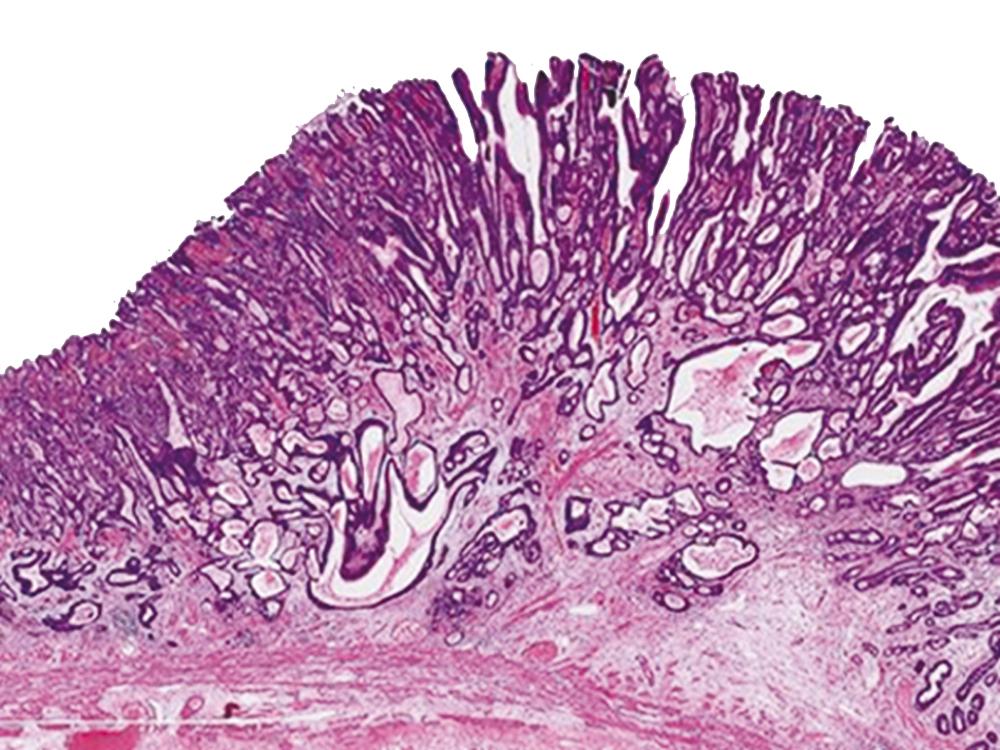
Similar to dysplasia, most EGCs are diagnosed in men older than 50 years of age; this is a younger age than for advanced adenocarcinoma, reflecting the amount of time required for progression from early to advanced disease. , Most patients are asymptomatic, but some complain of symptoms that mimic peptic ulcer disease. , Epigastric pain and dyspepsia are the most frequently reported symptoms. They usually occur only within the last few months before diagnosis. Most EGCs are small, between 2 and 5 cm, and they are typically localized on the lesser curvature around the angularis region. , In 3% to 13% of patients, multiple primary sites are present, and this has been shown to be associated with a poorer prognosis.
EGCs are divided based on their endoscopic appearance ( Fig. 25.2 ): protruding (type I), flat/superficial (type II), and excavating (type III) ( Table 25.3 ). , Type II is further subdivided into IIa (elevated) ( Fig. 25.3 ), IIb (flat), and IIc (depressed). Superficial EGCs (type II) account for the highest proportion of cases (80%), with type IIc being most common. Type IIb accounts for 58% of tumors that are smaller than 5 mm. The endoscopic appearance of EGCs has been shown to be a good indicator of the rate of lymph node metastasis, with the lowest rates reported in type I or IIa EGCs. Type IIa, which is defined as a lesion that is twice as thick as normal mucosa, and type IIc, which mimics benign ulcers, are difficult to detect endoscopically because of subtle features such as ease of bleeding and an irregular interface with surrounding mucosa. In such cases, obtaining multiple biopsies is advisable to secure a diagnosis.
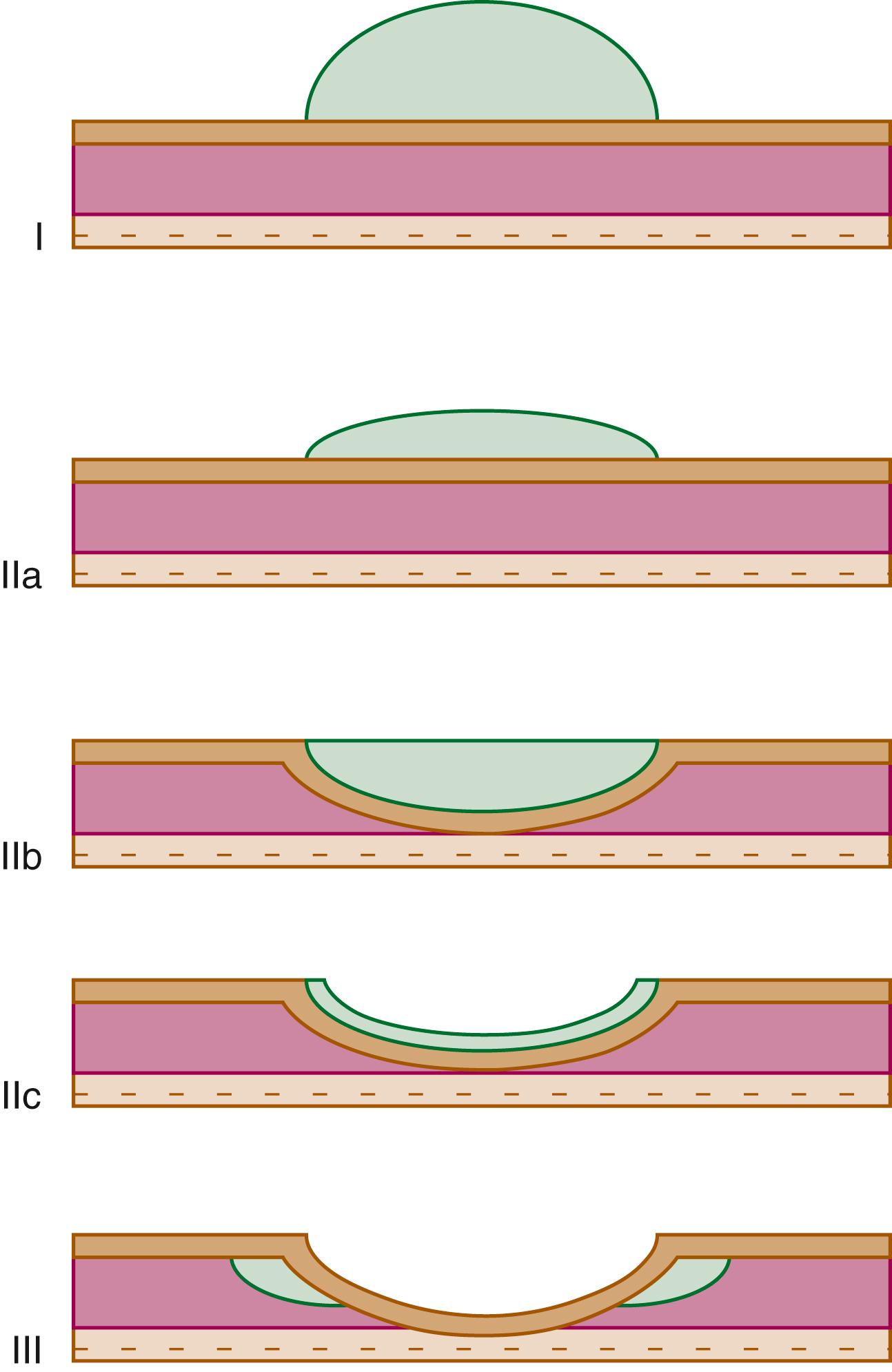
| Category | Description | Subcategory |
|---|---|---|
| 0-I | Protruding lesions | 0-Ip pedunculated |
| 0-Is sessile | ||
| 0-Isp semipedunculated | ||
| 0-II | Flat | 0-IIa flat elevation |
| 0-IIb flat mucosal change | ||
| 0-IIc mucosal depression | ||
| 0-III | Ulcerative | Excavated ulcer |
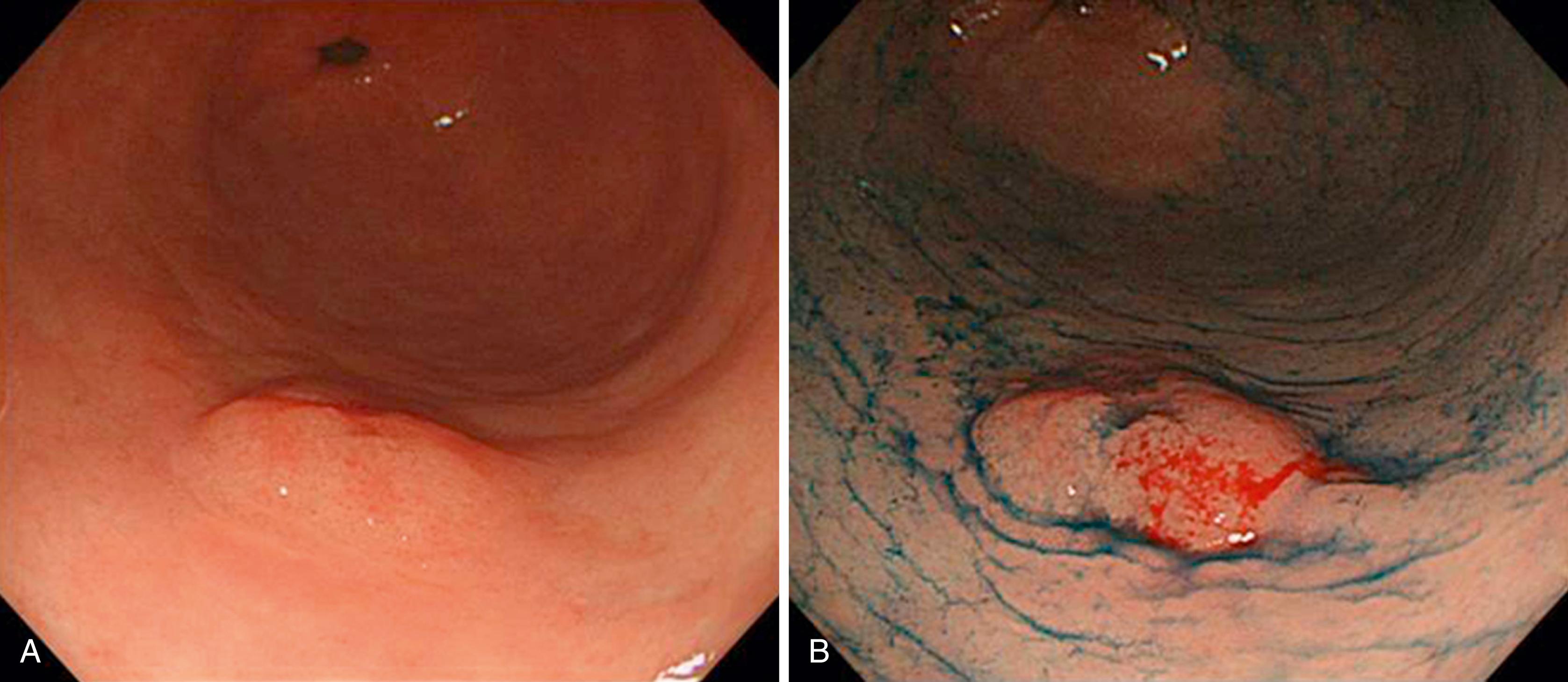
Microscopic variants of EGCs have been reported. Minute EGCs measure less than 5 mm in diameter, and although most are limited to the mucosa, submucosal extension is detected in as many as 15% of cases. , Superficial spreading EGCs are characterized by the presence of large, serpiginous ulcerations with neoplastic cells that spread laterally over a large area of mucosa.
The majority of EGCs are well-differentiated glandular carcinomas. Tubular and papillary variants represent 52% and 37% of cases, respectively, and may be difficult to differentiate from dysplasia because of the lack of obvious tissue invasion. Signet ring cell (SRC)/diffuse carcinoma ( Fig. 25.4 ) and poorly differentiated carcinoma represent 26% and 14% of cases, respectively, and are usually depressed or ulcerated (types IIc and III). , Diffuse-type (poorly cohesive) EGCs tend to show greater depths of invasion. The morphological classification of EGC is important because, in addition to the size and the endoscopic appearance (i.e., presence of erosion or not), patients may be treated conservatively via endoscopic resection rather than surgery.
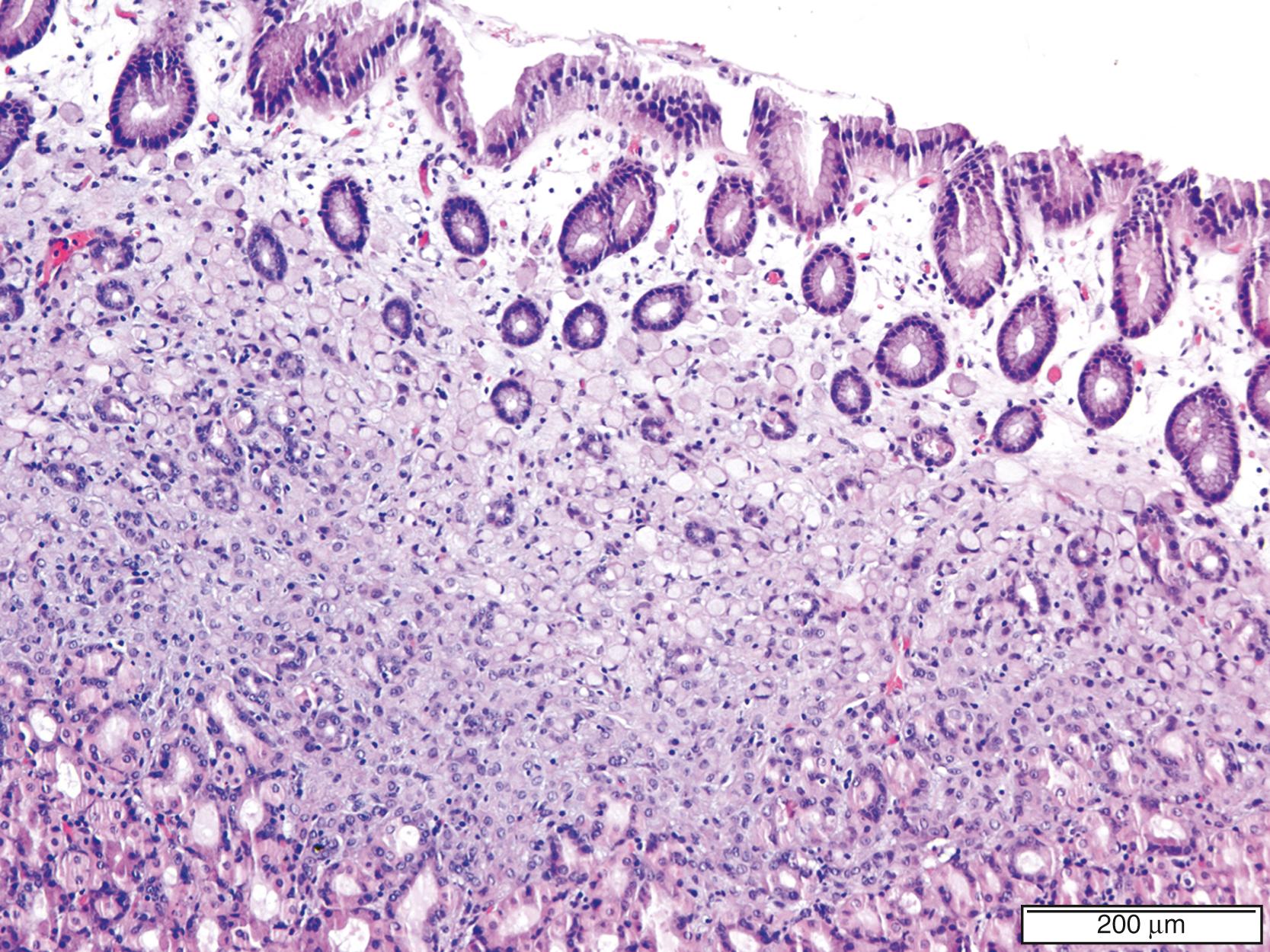
The differential diagnosis of EGC includes (polypoid and flat) high-grade dysplasia. However, the distinction is subjective and fraught by significant interobserver variation. In contrast with high-grade dysplasia, which shows only limited architectural atypia, EGC is composed of fused or branching tubular structures in some cases. Cribriforming and/or small withering glands can be seen in other examples. In most cases limited to the mucosa, fibroblastic desmoplastic response is absent, or only myxoid transformation of the lamina propria is observed.
In a series of patients with EGC followed conservatively without surgery, 63% of EGCs progressed to advanced carcinoma during a 6- to 88-month period. With resection, the prognosis of EGC is excellent, with 5-year survival rates greater than 90% reported in most series. , , , , Size of the tumor and depth of invasion are the two major prognostic indicators, and larger tumors have a greater risk of submucosal infiltration. , However, the risk of invasion should not be overlooked, even in very small tumors. In one series, 15.5% of tumors that measured 3 to 5 mm in diameter showed invasion into the submucosa. Lymph node metastases have been reported in 0% to 7% of intramucosal EGCs and are associated with a 5-year survival rate of almost 100%. , , The rate of lymph node metastases for EGCs that extend into the submucosa varies between 8% and 25%, and the 5-year survival rate for these tumors is 80% to 90%. ,
Endoscopic resection has now become the first-line therapy for early gastric cancer, with very low risk of node metastasis. Important characteristics considered in the decision making include the size of the lesion, whether it is ulcerated, the morphological subtype, and the differentiation. The risk of nodal metastasis is extremely low in a completely resected EGC that is devoid of vascular invasion and has no other unfavorable criteria (i.e., size and ulceration), and the procedure is deemed curative. , Because of the limitations of endoscopic mucosal resection (EMR) (limited to small lesions, frequent fragmentation, limitation in evaluating lateral margins), the vast majority of all early gastric cancers in East Asia (and a few centers in the West) are now treated by endoscopic submucosal dissection (ESD). Both, EMR and ESD techniques have distinct advantages and disadvantages. The selection of one technique over the other depends greatly on the location and characteristics of lesions ( Table 25.4 ) as well as the expertise of the gastroenterologist. EMR uses a snare and additional ancillary techniques (Cap EMR, band EMR) and frequently results in piecemeal resection. Consequently, EMR is associated with a higher risk of positive microscopic margins and local recurrence. ESD with a submucosal plan of resection provides a larger specimen with en-bloc removal. ESD is technically more challenging and is associated with a higher risk of perforation. A systematic approach for handling and assessing ER specimens is recommended to evaluate the key prognostic features appropriately. Correct handling starts with pinning the specimen before fixation, meticulous macroscopic assessment with orientation of appropriate margins, systematic sectioning, and microscopic assessment of the entire specimen.
 |

Whether eradication of H. pylori improves prognosis is unclear. However, the eradication of H. pylori decreased significantly the risk of metachronous gastric cancer. In a study of 132 patients with EGC who underwent endoscopic mucosal resection, no new cases of gastric cancer were observed after eradication, while in contrast new early-stage intestinal-type gastric cancer developed in 13.5% of untreated patients.
Advanced adenocarcinoma is defined as a tumor that invades the gastric wall beyond the submucosa. Most patients are men (male-to-female ratio of 2:1) in their fifth to seventh decades of life. Clinically, symptoms commonly include epigastric pain, dyspepsia, anemia, weight loss, hematemesis, and symptoms of gastric outlet obstruction. Some patients, particularly younger ones, have intraabdominal dissemination at presentation. Metastatic ovarian lesions (Krukenberg tumors) composed of diffuse-type/poorly cohesive cancer cells may develop in female patients. Advanced-stage gastric cancer (which cannot be surgically treated) has a median survival of approximately 9 to 10 months.
Advanced gastric carcinomas may display several different gross appearances, such as exophytic, ulcerated, infiltrative, and combined . These growth patterns form the Borrmann classification, which remains the most widely used system, albeit with limited therapeutic value. It divides gastric carcinomas into four distinct types ( Fig. 25.5 ): polypoid (type I) ( Fig. 25.6A ), excavating with sharply demarcated and raised margins (type II) ( Fig. 25.6B ), ulcerated without definite limits, infiltrating into the surrounding wall (type III) ( Fig. 25.6C ), and diffusely infiltrating (type IV) ( Fig. 25.6D ). The latter is also referred to as linitis plastica when it involves the majority of the stomach. Type III represents the most frequent type, followed by types II, IV, and I. ,
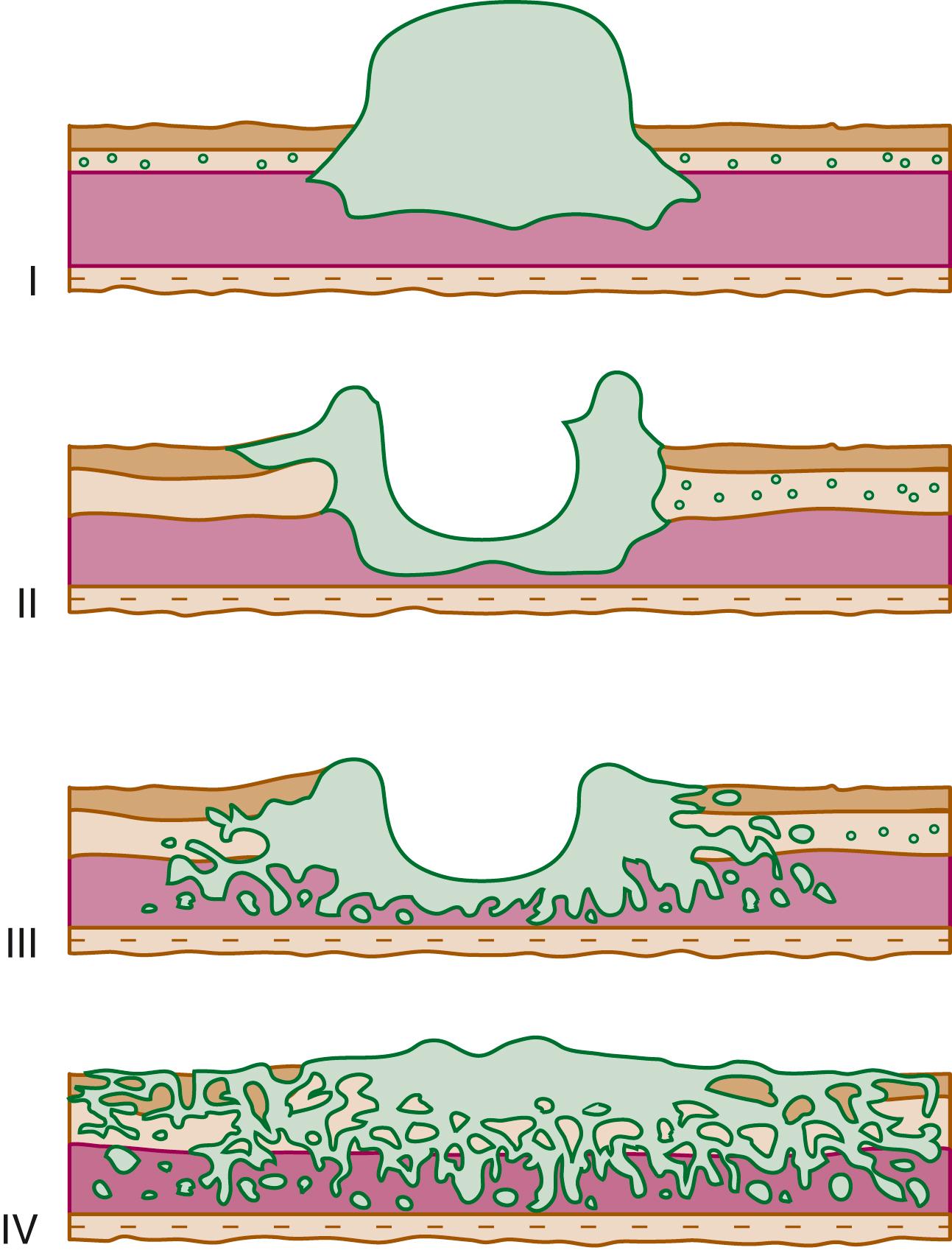
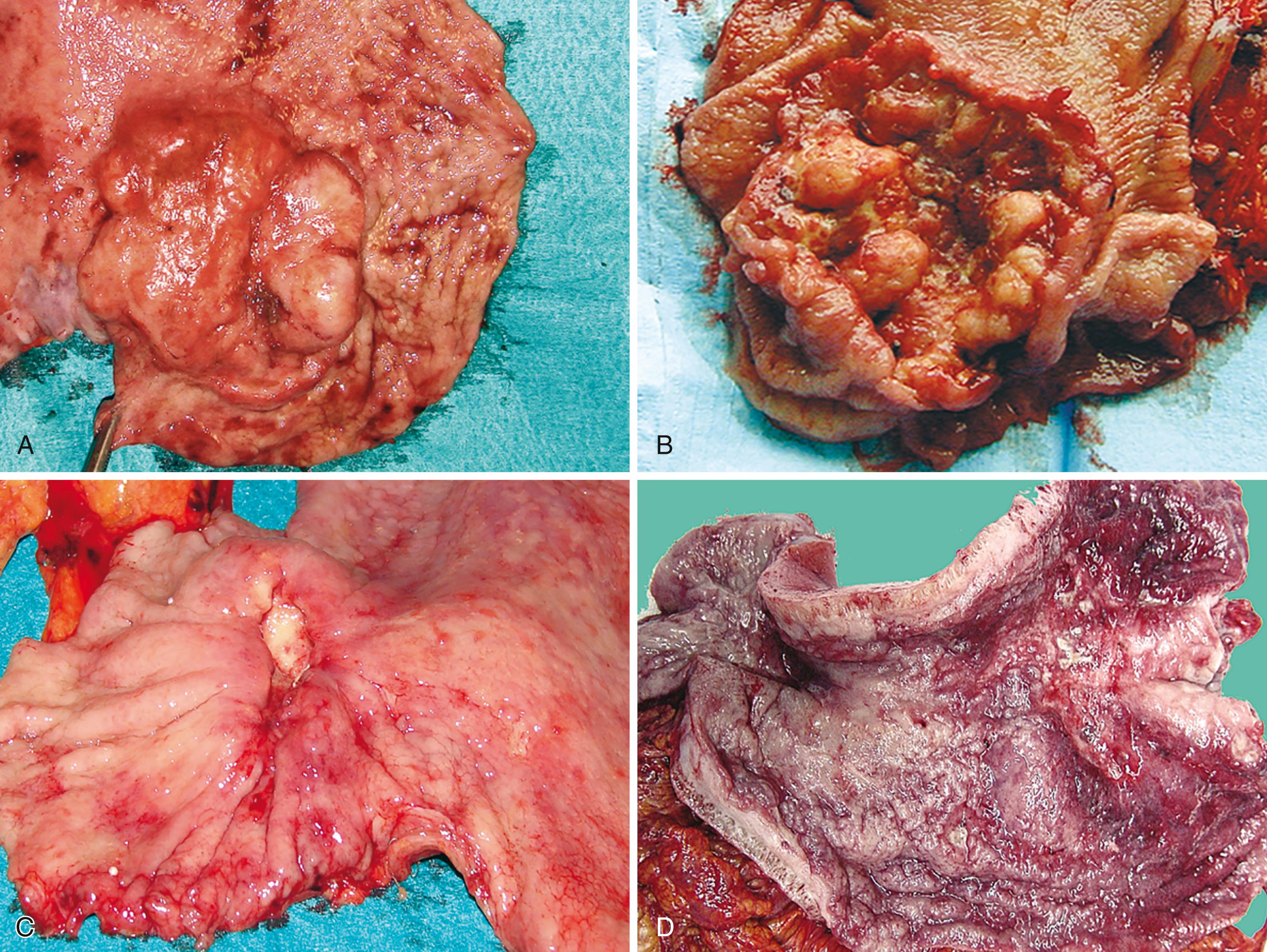
Gastric adenocarcinomas display marked heterogeneity at both the cytological and the architectural level. Cytologically, a combination of gastric foveolar, intestinal, and endocrine cell types usually constitutes at least a portion of all tumors. Ciliated tumor cells may also be observed. Mucin histochemical and immunohistochemical stains (MUC1, MUC2, MUC5AC, MUC6, and CD10) may be useful in highlighting the different cellular components. , , , In fact, based on mucin immunohistochemistry (IHC), a phenotypic classification of gastric cancer encompasses four phenotypes: G (gastric; MUC5AC+ and/ or MUC6+; MUC2− and CD10−), I (intestinal; MUC2+ and/or CD10+; MUC5AC− and MUC6−), GI (gastric and intestinal); and N (null). , , Type I (intestinal) is more common in differentiated gastric cancers than in undifferentiated ones. The loss of MUC5AC expression was identified as an independent, poor prognostic factor in EGC, regardless of the histological type. At variance, other studies showed that the foveolar phenotype (characterized by MUC5AC expression) was associated with poor prognosis in differentiated early gastric cancers. Moreover, epithelial nonpolypoid dysplasia of the stomach with gastric immunophenotype was shown to display features of biological aggressiveness and may represent the putative precursor lesion in a pathway of gastric carcinogenesis originated de novo from the native gastric mucosa, leading to gastric-type adenocarcinoma. For each histological subtype, a shift from the gastric to the intestinal phenotype is commonly observed with tumor progression.
The 5-year survival of patients with advanced gastric cancer is estimated to be approximately 20%, and only surgery, including lymphadenectomy, can offer cure. 135a , 135b However, early detection and new anticancer drugs have prolonged survival. 135c , 135d
The WHO Classification of Tumours, 5th edition, published by the World Health Organization in 2019, is the classification that should be favored in reporting because it will bring uniformity worldwide. The classification recognizes five major types of gastric adenocarcinoma (tubular, papillary, mucinous, poorly cohesive, and mixed) as well as other rarer subtypes (gastric (adeno)carcinoma with lymphoid stroma, hepatoid adenocarcinoma and related entities, micropapillary adenocarcinoma, and gastric adenocarcinoma of fundic gland type). Other histological types of gastric malignant epithelial tumors encompass squamous cell carcinoma, adenosquamous carcinoma, and undifferentiated carcinoma.
This is the most common type, with a relative frequency ranging from 45% in Europe to 64% in Japan, and even higher in elderly patients. Tubular structures, branching glands, or acinar structures compose it ( Fig. 25.7A ). The neoplastic cells can be columnar, cuboidal, or flattened by intraglandular luminal mucin or cell debris ( Fig. 25.7B ), and the glands can display cystic dilation ( Fig. 25.8 ). A clear cell variant has been described ( Fig. 25.9 ), with a predilection for the esophagogastric region. A poorly differentiated component may coexist, composed of compact sheets of tumor cells ( Fig. 25.10 ). At the other end of the spectrum, (extremely) well-differentiated gastric adenocarcinoma has been described ( Fig. 25.11 ), either with gastric or intestinal differentiation, , some mimicking complete-type intestinal metaplasia in the stomach. Tubular adenocarcinoma is usually diagnosed in older patients (commonly in the antrum or body), tends to form polypoid or fungating masses, and is strongly linked to chronic H. pylori infection, atrophic gastritis, and intestinal metaplasia.
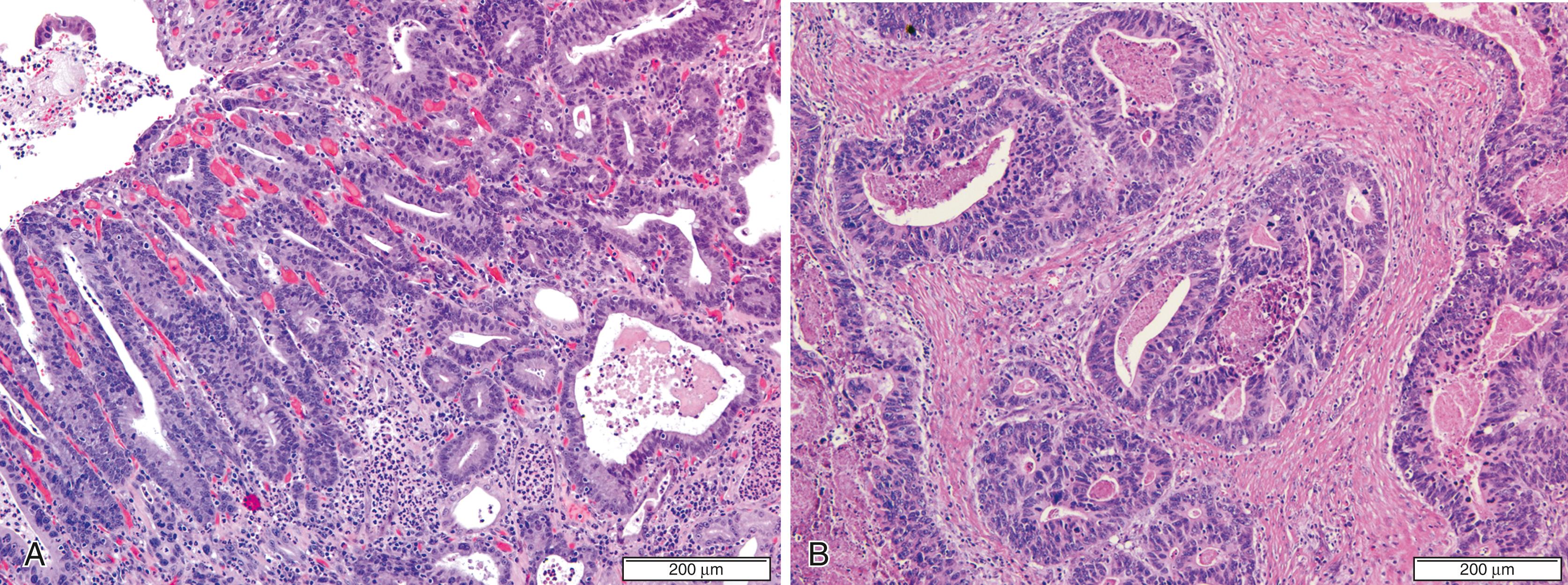
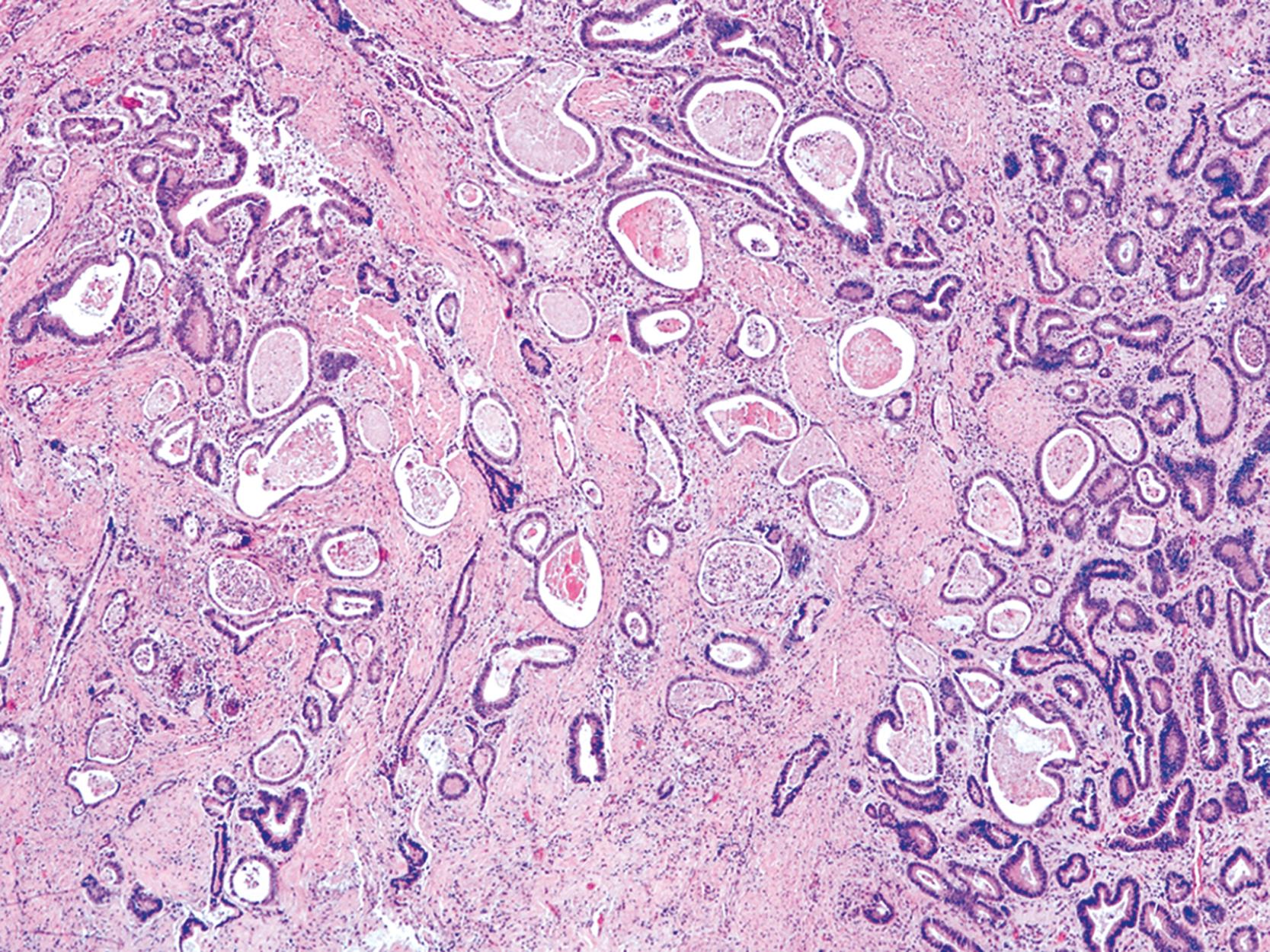
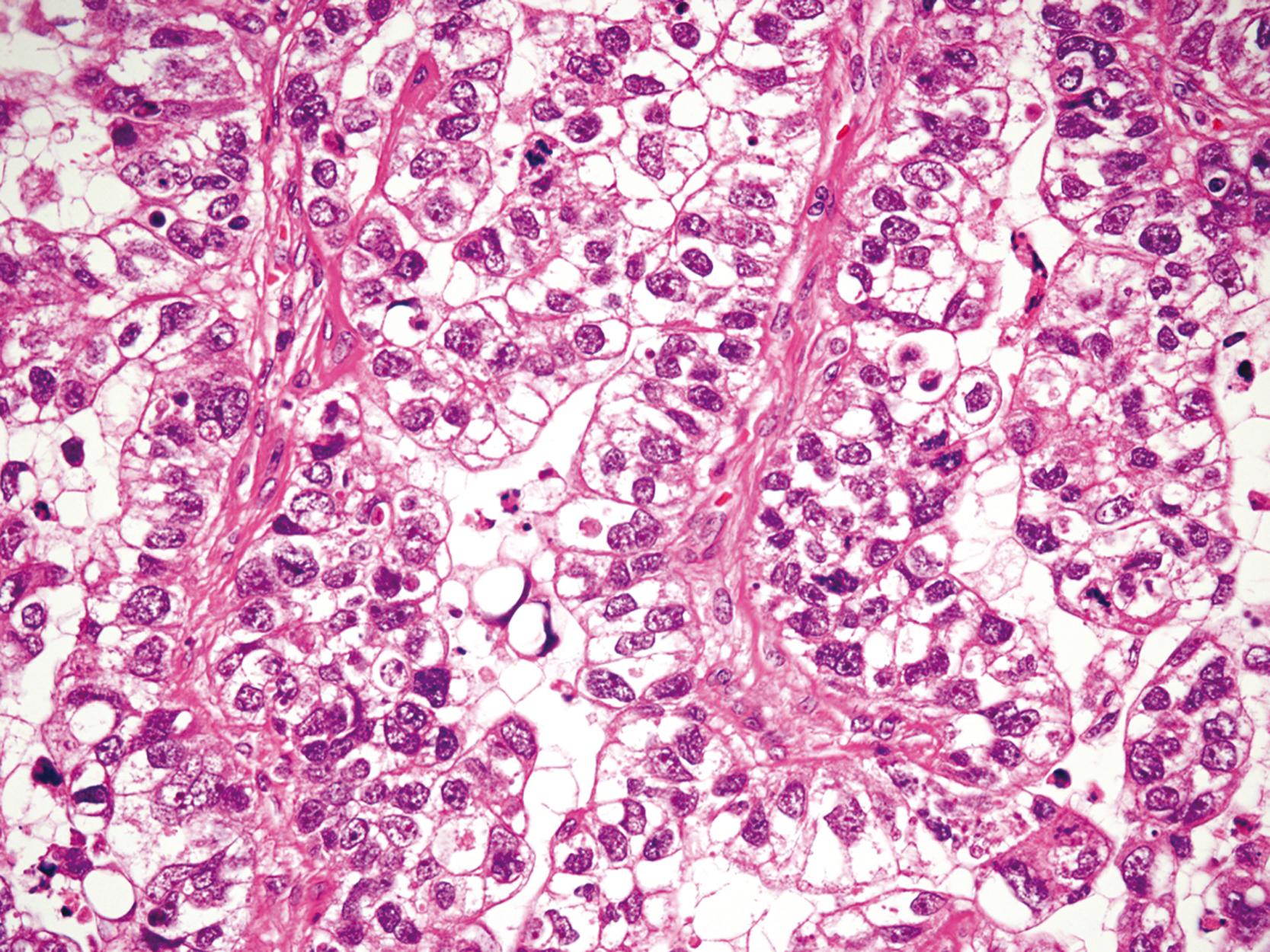


This type is characterized by long epithelial projections scaffolded by central fibrovascular cores ( Fig. 25.12 ) and usually shows an exophytic growth pattern. It accounts for 6% to 11% of all gastric carcinomas, affects older patients, occurs mainly in the proximal stomach, and is frequently associated with liver metastases. A higher rate of lymph node metastases has been reported for papillary adenocarcinoma compared with tubular adenocarcinoma. Combined tubulopapillary variants are also common.

Poorly cohesive tumors were previously included in a general category of SRC carcinoma, even in cases in which SRCs were not identified. The current WHO classification recognizes that a general category of poorly cohesive tumors better reflects the wide diversity of tumors composed of neoplastic cells that are isolated or arranged in small aggregates and may display various morphologies. The SRC type is composed predominantly or exclusively of signet ring cells characterized by a central, optically clear or eosinophilic, globoid droplet of cytoplasmic mucin with eccentrically placed nuclei with crescent shapes ( Fig. 25.13A –B). Gland formation is not a normal component of this tumor. Signet ring cells may form a lacelike glandular or delicate microtrabecular pattern, especially in the mucosa ( Fig. 25.14 ).


Other variants of poorly cohesive carcinomas (non-SRC type) have also been observed, such as tumors that contain cells resembling histiocytes, deeply eosinophilic cells with neutral mucin, and anaplastic cells with little or no intracellular mucin ( Fig. 25.15 ). The latter display bizarre/pleomorphic cells and are related to poor prognosis.

When poorly cohesive carcinomas invade to deeper levels of the gastric wall, they commonly initiate a marked desmoplastic reaction with loss of the morphological features of SRCs ( Fig. 25.16 ). PAS stain may be useful to identify the neoplastic cells ( Fig. 25.17A –B).


Poorly cohesive carcinomas are found most commonly in the gastric body and in younger patients, and they account for 20% to 50% of gastric adenocarcinomas, with higher frequencies in Japan.
Although associated with H. pylori infection, the carcinogenetic sequence of the poorly cohesive gastric cancer is not well characterized. ,
Become a Clinical Tree membership for Full access and enjoy Unlimited articles
If you are a member. Log in here